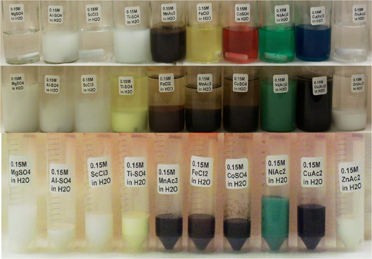NRL Researchers Develop Novel Method to Synthesize Nanoparticles

This figure illustrates the ease with which grams of many different types of oxide nanoparticles can be prepared in a single step. The first row of sample vials shows the initial salt solutions of the different elements. The second row shows the product after reaction with potassium superoxide (KO2) and the addition of methanol. The bottom row shows the grams of nanoparticles after being purified by centrifugation. (Photo: U.S. Naval Research Laboratory)
“Typically, the synthesis of oxide nanoparticles involves the slow reaction of a weak oxidizing agent, such as hydrogen peroxide, with dilute solutions of metal salts or complexes in both aqueous and non-aqueous solvent systems,” said Dr. Thomas Sutto, NRL research chemist. “The rapid exothermic reaction of potassium superoxide with the salt solutions results in the formation of insoluble oxide or hydroxide nanoparticulates.”
An important advantage of this method is the capability of creating bulk quantities of materials. NRL has demonstrated that large quantities (over 10 grams) of oxide nanoparticles can be prepared in a single step, which is approximately four orders of magnitude higher yield than many other methods. The metal concentrations, usually in the millimolar (mM) amount, need to be low in order to prevent aggregation of the nanoparticles into larger clusters that could significantly limit the amount of material that can be prepared at any one time.
Oxide nanoparticles have been shown to be crucial components in numerous applications to include electronic and magnetic devices, energy storage and generation, and medical applications such as magnetic nanoparticles for use in magnetic resonance imaging (MRI). In all of these applications, particle size is critical to the utility and function of oxide nanoparticles—decreased particles size results in increased surface area, which can significantly improve the performance of the oxide nanoparticle.
In order to demonstrate the broad scale applicability of this new method, oxide or hydroxide nanoparticles have been prepared from representative elements from across the periodic table to rapidly produce nanometer sized oxides or hydroxides. In addition to the elements converted to oxide nanoparticles in the above illustration, it has also been shown that oxide nanoparticles can be prepared from second and third row transition metals, and even semi-metals such as tin, bismuth, thallium and lead.
One exciting aspect of this technique is that it can also be used to produce blends of nanoparticles. This has been demonstrated by preparing more complex materials, such as lithium cobalt oxide—a cathode material for lithium batteries; bismuth manganese oxide—a multiferroic material; and a 90 degrees Kelvin (K) superconducting Yttrium barium copper oxide material. As such, this new synthetic route to oxide nanoparticles also shows great promise for a multitude of other catalytic, electrical, magnetic, or electrochemical processes, from novel cathodes to solution preparation of other types of ceramic materials.
About the U.S. Naval Research Laboratory
The U.S. Naval Research Laboratory is the Navy's full-spectrum corporate laboratory, conducting a broadly based multidisciplinary program of scientific research and advanced technological development. The Laboratory, with a total complement of approximately 2,500 personnel, is located in southwest Washington, D.C., with other major sites at the Stennis Space Center, Miss., and Monterey, Calif. NRL has served the Navy and the nation for over 90 years and continues to meet the complex technological challenges of today's world. For more information, visit the NRL homepage or join the conversation on Twitter, Facebook, and YouTube.
Media Contact
All latest news from the category: Materials Sciences
Materials management deals with the research, development, manufacturing and processing of raw and industrial materials. Key aspects here are biological and medical issues, which play an increasingly important role in this field.
innovations-report offers in-depth articles related to the development and application of materials and the structure and properties of new materials.
Newest articles

Silicon Carbide Innovation Alliance to drive industrial-scale semiconductor work
Known for its ability to withstand extreme environments and high voltages, silicon carbide (SiC) is a semiconducting material made up of silicon and carbon atoms arranged into crystals that is…

New SPECT/CT technique shows impressive biomarker identification
…offers increased access for prostate cancer patients. A novel SPECT/CT acquisition method can accurately detect radiopharmaceutical biodistribution in a convenient manner for prostate cancer patients, opening the door for more…

How 3D printers can give robots a soft touch
Soft skin coverings and touch sensors have emerged as a promising feature for robots that are both safer and more intuitive for human interaction, but they are expensive and difficult…





















